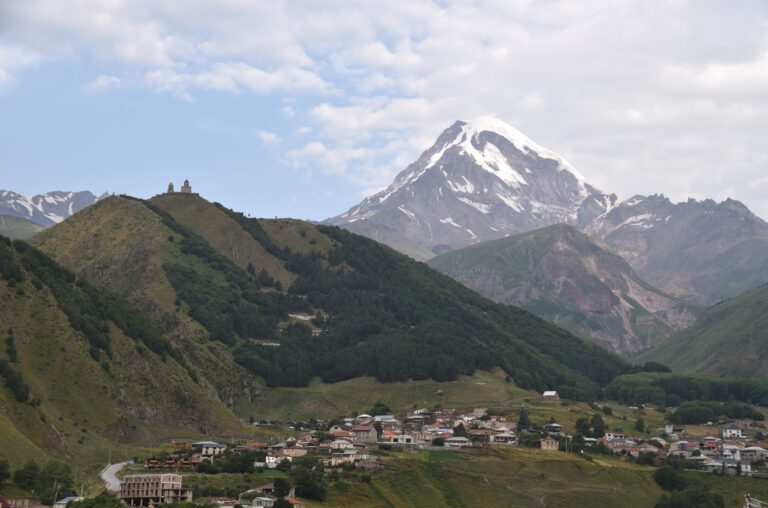Reassessing Relations with China: Nepal’s New Negotiation Strategy

In late June this year, top diplomats from Nepal and China gathered in Kathmandu for a bilateral meeting expected to bring clarity on two issues in Sino-Nepali relations: the future of the Belt and Road Initiative (BRI) and Nepal’s ratification of the boundary management agreement. Judging from the divergent tones in their respective press releases, however, it seems that Beijing and Kathmandu did not reach a consensus on these issues. Nevertheless, the relationship remains strong – mainly due to China’s continued importance as Nepal’s major economic partner.
The Himalayan Handshake
China and Nepal share a 1,400 km-long border located in some of the world’s highest mountains. This makes the construction and maintenance of roads linking the two countries a significant challenge. Indeed, when Nepal joined the BRI in 2017, its main impetus was to seek Chinese investment in its transportation hubs, a tradition dating back to 1965 when the China-Nepal Friendship Highway linking Lhasa to the Nepali capital of Kathmandu was built.
When a major earthquake hit Nepal in 2015 and damaged several of its roads, the two countries transformed the Rasugawadhi-Kerung border crossing into an alternative connection to the friendship highway. There is also a potential railway project that, once finished, would provide an alternative link between Lhasa and Kathmandu. As part of this, China agreed to build the segment from Tibet to the Nepali border, while Nepal would build the remaining 72 km to its capital. Nepali hoped the railway would provide access to Chinese ports while diversifying the country’s trade routes. This is particularly important as without the railway, 95 percent of Nepal’s trade will have to continue flowing through India.
Through its Eximbank, China also invested in upgrading the airport in Pokhara, Nepal’s second-largest city. This was significant not only because Pokhara is a famous tourist destination but also because the upgrade became one of the largest Chinese investments in the country. The upgrade became part of the Trans-Himalayan Multi-Dimensional Connectivity Network, which, as part of the BRI, aims to link Nepal to China and the world. Currently, Nepal has limited railways, all of which are located in the south, thus missing reliable connections in the north.

This economic development has led to stronger political relations between the two states, as marked by what became known as the ‘Himalayan handshake’ – a term used by Nepali media to refer to the strengthening of Sino-Nepali relations. Prior to the boom in Chinese infrastructure projects, Nepal’s foreign economic actors came predominantly from India and the US. The peak of Sino-Nepali political relations came in October 2019 when Xi Jinping visited Nepal – the first such visit by a Chinese head of state in 23 years – and announced a series of large-scale development projects. It was during this visit that the agreement on boundary management was announced as well. Such cordial political relations have then further increased the flow of goods and people from China, with China becoming Nepal’s second-largest import partner (after India), accounting for over 13 percent of its overall imports in 2022.
The success of China’s economic and political engagement needs to be understood in terms of the economic, political, and cultural leverage India has historically held over Nepal. Indeed, not only has India long controlled all aspects of Nepal’s political and economic life, but there is also a sense of shared cultural proximity, spanning from the prevalence of Hindu beliefs to Bollywood movies and English-language education opportunities in the two South Asian states. Moreover, the two countries have an open border that allows for a free flow of people and goods. India accounts for 70 percent of Nepal’s exports and 63 percent of its imports, with around four to eight million Nepalis working in India – a significant number for a country of 30 million.
Despite India’s importance for Nepal’s economy, however, there are several grievances on the Nepali side regarding their South Asian neighbor. These include discriminatory practices faced by Nepalis living and working in India, New Delhi’s influence over Kathmandu’s politics, a 2015 blockade of petroleum imports, and most recently, a territorial dispute caused by a controversial map published by New Delhi that claims a territory in northwestern Nepal as part of India. It was against this background that China’s relations with Nepal improved. For example, Beijing managed to turn the 2015 petroleum blockade into a charm offensive opportunity by offering emergency fuel deposits.
Pandemic Fallout
Following the peak in Sino-Nepali relations, 2019 marked a downward turn in bilateral relations between the two states. This was mainly due to the impact of COVID-19 on Nepal’s transport and tourism industries – the two main avenues for China’s presence in Nepal. Xi Jinping’s zero-COVID policy meant that border crossings were closed for months, causing Nepal to rely solely on India for land transportation. The policy also led to several tourist companies and hotels preparing for an influx of Chinese tourists going bankrupt.
While the number of Chinese tourists in Nepal was not significant until 2013, it jumped to 100,000 that year and was expected to reach half a million by 2020 – a noteworthy increase for a country where tourism is one of the most important sectors of the economy. At the same time, the sector’s reputation was tarnished by what was supposed to become a flagship Chinese project in Nepal – the much-hailed upgrade of the Pokhara airport. The airport, which cost $216 million and was supposed to accommodate large planes, has been heavily underused since its completion in 2022, serving only domestic flights, as even flights from China do not land there. This is because the current state of the airport does not allow for larger planes to land safely, although there is no definitive information on the matter. There is also an ongoing parliamentary investigation into the technical feasibility of another airport built with Chinese loans.

As with numerous other BRI projects around the world, several Chinese infrastructure projects in Nepal have thus failed to deliver. Another example of such failed projects is the Lhasa-Kathmandu railway, the construction of which was stalled due to Nepal’s inability to fund its segment of the railway. These failed projects have popularized debt-trap references in Nepali media and political discourse. Moreover, Nepal’s government has requested China to convert the loan provided for the Pokhara airport into a grant, indicating that it has no intention of paying for what has effectively become an economic disaster. Kathmandu is also increasingly aware of the risks associated with its growing trade deficit with China.
Negotiated Cooperation
There is no doubt that Nepal has benefited from its strong relationship with China. It has allowed Nepal to gain credible leverage with India and, to some extent, also with the US, especially in trade and investment relations. Because of this, the relationship with China is likely to persist, although, moving forward, Kathmandu will likely base the relationship on more pragmatic expectations of what Beijing can deliver.
On one hand, there are signs that both sides want to expand trade relations. For example, Chinese electric cars and motorbikes, the latter of which are an essential means of transportation for most Nepalis, can be seen on the streets of Kathmandu, competing with those made in India. As the two celebrate 70 years of diplomatic relations next year, China has also agreed to turn Nepal’s initiative Visit Nepal 2025 into an opportunity to attract Chinese tourists.
On the other hand, the fate of the Chinese social media platform TikTok is emblematic of the ongoing disagreements between Kathmandu and Beijing. Both TikTok and WeChat became popular in Nepal as Chinese tourists started arriving in large numbers, yet financial transactions over these platforms do not bring tax revenue for the Nepali government. Moreover, as the platform was involved in several cases of financial fraud and cyber-attacks in 2019, Kathmandu decided to follow India’s example and ban TikTok in November 2023. It was only after negotiations with the social media platform concerning content monitoring that Nepal decided to reauthorize the platform in August 2024.
Beijing is discovering that agreements with Kathmandu do not come as easily as before, and that more China-critical views have now entered the public discourse. As of now, China has not managed to find a successful way of navigating this new landscape, as the wolf-warrior rhetoric of its current Ambassador Chen Song, who does not hesitate to attack Nepali journalists on X or mock Nepal’s governance problems, seems to indicate.
Despite, or arguably because of, the asymmetry in Sino-Nepali relations, including a significant trade deficit in favor of China, Nepal is no longer agreeing to all demands from China. Neither is it welcoming all economic projects funded by Chinese loans. Indeed, Kathmandu’s increasing tendency to reject Chinese projects or demand renegotiating the terms of these projects were largely unprecedented before 2019, signaling that Kathmandu is learning to play its cards better.
Written by
Filip Noubel
nasredinhojaFilip Noubel is Senior China Analyst at AMO, where he specializes in Chinese domestic politics and society and Cross-Strait (China-Taiwan) relations. He has more than three decades of research experience focusing on China. Filip has experiences as an analyst, commentator, journalist, interpreter and consultant for various organizations, including International Crisis Group, Institute of War and Peace Reporting, International Center for Communication Development, Global Voices, etc. Filip Noubel received the DEA (Diplôme d'Études Approfondies) at the National Institute of Oriental Languages and Cultures (INALCO) in Paris. He also studied at the Central University for Minorities in Beijing.


